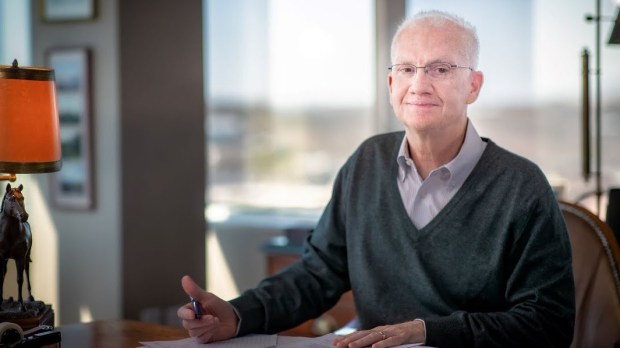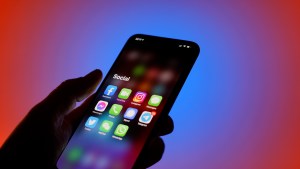John Corcoran, appointed by Pope Francis as a consultant for the Dicastery for Communication on September 29, is not the average communicator. In 1996 he founded a leading life sciences consultancy company, Trinity Life Sciences, which today operates globally. He has more than 30 years of consulting experience in the pharmaceutical and biotechnology industries, with expertise in commercialization strategy, data management, digital platforms, and analytics.
On the other hand, he also works in Catholic communications, as he is the chair of the board of trustees of iCatholic Media, an entity of the Archdiocese of Boston that includes the America’s Catholic Television Network CatholicTV.
Corcoran spoke to Aleteia about how he sees the Catholic Church’s communication and what fresh perspective he hopes to bring in his new role.
I wish for a world that “finds the treasure” and fills life with joy.
Aleteia: With your unique professional background, what new perspective on digital communication are you bringing to a 2000-year-old institution such as the Catholic Church?
Corcoran: Digital engagement has become an immutable facet of modern life. Technology is never a substitute for the in-person practice of the faith, but digital engagement can be undertaken effectively to advance the mission of the Church. The need to engage more with Catholic and non-Catholic communities has never been greater. As I begin my assignment with the Dicastery, I acknowledge the profound changes in technology and digital engagement that are occurring at an unprecedented pace. For example, in the early 2000s there were approximately 750 million cell phone subscriptions worldwide, whereas now there are over eight billion, more than the global population. Similarly, Facebook now has over two billion users (none in 2000), and Tik Tok over one billion users despite having launched only six years ago.
Part of the uniqueness and innovation of the so-called “digital continent” is that the dissemination of content can be measured and targeted. While established media forms have partial means to measure consumption (TV ratings, radio listenership, etc.), the digital landscape is fully enabled from a data and analytics standpoint. With acknowledgement of the important need to protect privacy and user information, communication in the modern world can be targeted so that the content delivered aligns with user interests. The Internet is not geographically constrained and the ability to reach large audiences seamlessly and instantly is valuable. The Church has always communicated and presented the Gospel in all languages and to all populations, with digital pathways accelerating this opportunity.
Aleteia: What’s the Church’s relationship with digital forms of communication and where can it improve in its methods of reaching people?
Corcoran: The Church does not need to be an early adopter of technology. The Church can, however, be opportunistic in its use of communication, including traditional and digital forms. The particular challenge is to offer content in multiple forms and pathways. I know from my experience in the Archdiocese of Boston that sacramental offerings (online Mass, Rosary, etc.), when made available in digital formats, resonate deeply with the faithful and those who are drawing nearer to Catholicism. But faith can deepen with greater exposure to Scripture, to Catholic music and literature, to art, and much more. The “white space” for Catholic audiences and for those discerning or who are attracted to the faith is limitless.
Pope Francis spoke to this theme in his message to the Monterey conference (Mexico) this past August, noting that the Church “must find new ways to proclaim the heart of the Gospel to those who have not yet encountered Christ.” He called for “a pastoral creativity capable of reaching people where they are living—not waiting for them to come—finding opportunities for listening, dialogue, and encounter.”
Aleteia: Do you believe the Church has kept up with the fast-paced world of digital communication and been able to relay its message correctly?
Corcoran: For all organizations using digital communication, including the Church, “effectiveness” is measured not simply by the mere “deployment” of technology. Intentionality is the key to broad acceptance and impact. The Holy Father has reminded us that communication must be characterized by the principles of “participation and sharing,” and that such outreach is effective only when it becomes “witness.” Communication is thus seen through a lens that is dynamic and purposeful, even if the Church is itself not digitally based, or technology driven.
Communication styles and approaches are always evolving and have been since the beginnings of the early Church. It started with the printing press (1440), then radio (1920) and television (1927), and now the pace of innovation has accelerated with hand-held mobile phones (1973), the Internet (1983), search (Google, 1996), and more. The Church has interpreted and deployed these and other innovations carefully and in alignment with its salvific mission. With history as a guide, we know that the pace of technology will drive future changes and the Church must remain opportunistic and circumspect in its understanding and use of these technologies. This new frontier of digital communication, in tandem with the Church’s existing media footprint, opens a new and exciting chapter in evangelization. The Dicastery for Communication is at the center of this.
Aleteia: In a world where young people prefer social media apps to more traditional forms of media, where do you believe the field of evangelization through communication outlets is headed in the near future?
Corcoran: Evangelization through digital means is a possibility at levels unimaginable but a generation ago. Pope Francis has affirmed this reality noting that digital engagement allows the Gospel to be shared “without even leaving one’s door.”
“The digital world – the social networks that are so pervasive and readily available – dissolves borders, eliminates distances, and reduces differences.” The Church can embrace these realities while acknowledging and navigating the challenges that over-reliance on these forms of communication can bring. The work of the Dicastery will be elevated by these new forms of communication, while not abandoning traditional forms, which remain critical for many. The truism of meeting the faithful “where they are” now can be extended further using all forms of media. What a powerful opportunity this suggests!
The truism of meeting the faithful “where they are” now can be extended further using all forms of media. What a powerful opportunity this suggests!
Aleteia: What is the potential of evangelization through social media in your opinion?
Corcoran: There is a structural element to digital communication that is often overlooked. Broadly speaking, “media” denotes any/all “channel(s)” of communication. I would also extend this definition to include required elements of content and distribution. In the context of the Church, the former is centered on the Gospel and Church teachings, the latter on the dissemination of that content. Most published sources indicate that average daily Internet use per person globally now exceeds seven hours per day. Digital evangelization allows for unique forms of connectivity that enable and deepen “community.” This is particularly critical for reaching young people, who consume digital content differentially and at high levels. This past July the Holy Father spoke of evangelization as less a form of “personal activism,” and more a witness of love. This can be driven home powerfully through social media and Internet-based engagement.
Aleteia: You are a successful businessman. Why did you decide to give a good part of your time, as a volunteer, to the service of Catholic communication?
Corcoran: It is a great honor to share with the Church (and the Dicastery for Communication) my perspectives and insights in communications, drawn from my past experience in data and analytics. I know first-hand that “mission does indeed revitalize faith” and I wish for a world that “finds the treasure” and fills life with joy. This is the most powerful and fundamental promise of digital communication and evangelization. Joyfully sharing the faith is what the Dicastery for Communication’s work centers around. It is a “joy” for me to be invited to participate in this and I look forward to my association.


